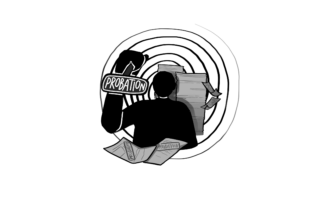This editorial represents the unanimous opinion of all 15 Outlook editors.
On Aug. 31, a water pressure drop set off a fire alarm toward the end of second period. This issue, along with the increased frequency of drills planned for the school year and the reiteration of emergency safety procedures, has led to concerns about student and staff response in regard to safety precautions. The Aragon administrative team ran an efficient process when the fire alarm went off and has been educating the Aragon community on safety procedures throughout the beginning of the year. Despite this, there are still issues that need to be addressed. The editors of The Aragon Outlook believe that the skepticism around the likelihood of emergencies and the nonchalance established within the school diminishes the purpose of drills and increases the safety risks in actual emergencies.
Despite the fire alarm going off unexpectedly, many students were nonchalant about evacuating the building. Some teachers were also frustrated that their classes were interrupted by the alarm. In the case of a real fire or emergency, this lack of urgency could cause harm to students and faculty, yet many teachers and students were more concerned about reduced class time. Tests can be made up at a different time. In the case of a real emergency, lives are at risk. To prepare for said emergencies, drills should be conducted as if an actual emergency was taking place that students and faculty should participate seriously.
All faculty members, regardless of whether they are on campus full-time or not, should be made aware of campus specific safety procedures in the event of an emergency.
Aragon has scheduled six drills for the rest of the school year, as is legally required by the state of California to ensure students and staff are prepared for emergencies. Maintaining a balance between doing enough drills and preparing properly is key. Too many drills could become repetitive, resulting in desensitization and a lack of responsiveness in an emergency. However, if we don’t practice enough drills throughout the year, students and faculty may forget the emergency protocols. The safety of students and staffulty should be prioritized. So while it may be wise to limit the number of drills per year, information about emergency procedures should be communicated more frequently.
Another issue that came to light when the fire alarm went off was the lack of experience substitute teachers and dual enrollment teachers had when it came to safety procedures on campus. All faculty members, regardless of whether they are on campus full-time or not, should be made aware of campus specific safety procedures in the event of an emergency.
If detailed briefings can’t be provided for all faculty on campus, an easily accessible list of procedures should be placed either by or in the emergency bag of every classroom. Also, teachers should be required to keep a map of meeting spots in evacuation areas to minimize confusion and panic. Students and teachers should also designate a person to carry the emergency bag and associated items on their way out the door.
The editors of The Aragon Outlook urge the Aragon community to take drills seriously. We recognize the importance of being efficient to hopefully maintain a semblance of efficiency in an emergency.



